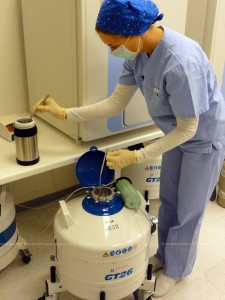Cutting-edge medical procedures provide women with the opportunity to have some of their oocytes frozen and “stored” as a precautionary measure. This is intended to preserve the positive status quo of their fertility at the time of cryopreservation, which in turn represents an option for achieving a pregnancy using their own “younger” oocytes in a future IVF cycle.
The underlying motives can be of both of a sociological nature, as well as of a medical nature. Statutory provisions do not exist to the same extent for both aforementioned aspects.
Thus, for example, there are countries where this procedure can be carried out only if medically indicated, for example in patients undergoing chemotherapy which may have a major damaging impact on their oocytes.
Freezing oocytes for sociological reasons (“Social Freezing”)
There are now a number of terms used for the cryopreservation of unfertilized eggs, such as “Social Freezing”, “Fertility Preservation”, “Egg Freezing”, “Social Egg Freezing”.
As the name implies, “Social Freezing” is rather a matter of social motivations. If, for example, a woman has not yet met “Mr. Right” to start a family or chooses to delay childbearing for her career development. Owing to longer education and training periods, women enter their working lives much later than was the case in the past. In the light of this development, family planning is to be adjusted to the changing realities.
What do experts have to say about “Social Freezing”?
Specialist in reproductive medicine and founder of the IVF centers holding the same name, Prof. Dr. Herbert Zech:

“It is my experience, that women opting for ‘Social Freezing’ have taken their decision in responsible, diligent and intelligent manner. This gives them a security, which takes away the pressure around the childbearing. However, the storage of unfertilized oocytes as a precautionary measure should in no way contribute to an attitude of not trying to conceive naturally.”
According to Prof. Zech, the period between the ages of 20 and 30 is the best time for “Social Freezing”, because then female fertility is at its peak. The procedure is aimed at avoiding a decline in fertility due to the aging process.
Freezing oocytes for medical reasons (“Medical Freezing”)
In addition to the social motivations indicated above, the reasons for considering “Fertility Preservation” can often be found in medical problems and associated therapies or surgical interventions, as is the case
-
• in oncology patients prior to chemo- or radiation treatment
• in patients with premature ovarian failure
• in patients suffering from massive endometriosis on the ovaries
This offers these women the opportunity to fulfill their desire to have children at a later point in time, by using “Artificial Insemination” (IVF/ICSI/IMSI).

Course of the treatment
If a woman decides to have some of her oocytes cryopreserved, appropriate treatment at the IVF clinic starts with exhaustive consultation, among other things, with information on the applicable regulatory framework as well as on the nature of possible risks. Furthermore, a gynecological examination, a hormone analysis as well as serology testing (infection parameters) will be performed.
The treating specialist will then decide on the course and medication with respect to the hormonal stimulation of the ovaries. This is followed by regular ultrasound monitoring in order to be able to determine the optimum time for oocyte retrieval.
The growing ova are retrieved vaginally during a minor surgical procedure. Typically, the woman undergoes this procedure in a sleep-like state (sedoanalgesia). The oocytes are then frozen in a closed carrier device at -196° and “stored” in a nitrogen tank.
The maximum storage time is governed by the respective national legislation.
Finally, it can be noted that the legal basis for freezing and “storing” own oocytes vary from one country to another. This gives rise to various possibilities as to how women may benefit from the procedure – be it for sociological aspects or medical reasons.
Links:
» Social Freezing / Medical Freezing – Oocyte preservation
(Topic-Special | https://www.fertility-treatment-blog.com)
(Start page | https://www.fertility-treatment-blog.com)
(Page | https://www.fertility-treatment-blog.com)
















